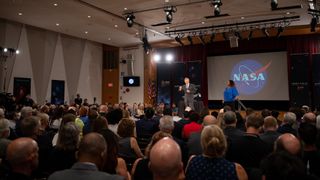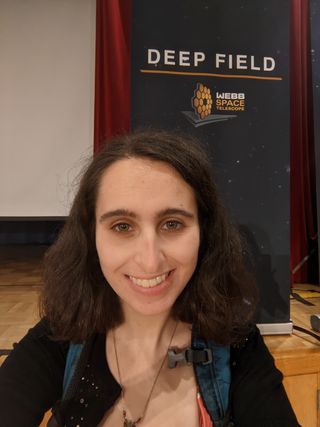The James Webb Space Telescope made Maryland the center of the universe for a day. Here's what it was like.
A tale of scientists, cheerleaders and the majesty of the universe.

GREENBELT, Md. — It's 9:30 a.m., and I'm in a crowded auditorium at NASA's Goddard Space Flight Center. Suddenly I hear, "Go, Webb, go!" and look up to see a group of people on the stage, some holding sparkly golden pom-poms, others cardboard hexagons covered in gold foil.
They are the cheerleaders of the James Webb Space Telescope, they say, and they are psyching us up — getting us ready for the big moment, whether we need it or not.
That moment is why we are all here — to witness the release of the telescope's first full-color science images. The cheerleaders exit the stage and there are some pre-event remarks: talking up the historical milestone, heralding he partnerships between different space agencies and companies, nodding to the impressive nature of the telescope. Most speakers thank those who worked on the telescope, and it's surreal to know that many are in the very same room. After everything that's been said, what's left to say might ordinarily seem like platitudes. Yet they feel genuine.
"Our rockets run on fuel," NASA administrator Bill Nelson said. "But inspiration is the fuel that drives NASA and indeed, drives humanity."
Gallery: James Webb Space Telescope's 1st photos
Live updates: NASA's James Webb Space Telescope mission
Give me a J!Give me a W!Give me an S!Give me a T! What does that spell? JWST! Let’s #UnfoldTheUniverse! #NASASocial pic.twitter.com/AIgGA7IoDnJuly 12, 2022
Finally, it's 10:30, and NASA's live-streamed presentation, broadcast from another building on the Goddard campus, begins — this is what we've been waiting for. The first image comes, and although it's the ultradeep field view we've already seen after a White House reveal, I'm happy to marvel at it all over again. I'm caught off-guard when scientists release one additional gem: a spectrum of a tiny red speck in the background of the image that represents a galaxy 13.1 billion light-years away. Surprised and delighted applause breaks out in the auditorium. We might not all understand what it means, but it is the first truly new thing we've seen, and the amount of detail gleaned about a galaxy from near the dawn of time boggles my mind.
Next up is the spectrum of the exoplanet WASP-96 b, a puffy gas giant exoplanet that is about half the mass of Jupiter but larger in size. A graph appears on the screen showing a series of dips and rounded peaks labeled "H2O." It takes a second to register what that means: What was thought to be the only cloudless planet yet discovered might not have perpetually clear skies after all.
Get the Space.com Newsletter
Breaking space news, the latest updates on rocket launches, skywatching events and more!
"What you're seeing here is the telltale signature, the chemical fingerprint of water vapor," says Knicole Colón, Webb's deputy project scientist for exoplanet science. "And the other thing we can tell, actually, is that there's evidence of clouds and hazes."
It's fascinating, but we know there's something more beautiful to come.

As the next image appears, I hear a faint, awestruck expletive from the journalist next to me, who has just looked up from his laptop to see the Southern Ring Nebula projected on the big screen. The complicated structure of the rings around the nebula's turquoise center stands out in stunning detail, rendered in vivid gold and orange. We're still digesting the gorgeous photo when another appears from a second instrument. This view renders the nebula in reversed colors, with both of the stars in the binary system suddenly clear against its orange center. Until now, the second, dim star — the one ejecting all the gas astronomers have been admiring in countless telescope images — has been invisible.
We make a big jump into the past for the next image — at 290 million light-years away, this is Webb's most distant first target (apart from the ultradeep field). Stephan's Quintet seems to shift on the screen, with three of its galaxies in the process of merging together. The composite image uses both the main camera, NIRCam, and the mid-infrared MIRI to highlight the structure of the galaxies, with cosmic tails strung out from their interaction with each other.

One galaxy shines with sharp silvery stars and golden clusters, obviously far closer to Earth than the others. A jewel-toned MIRI image follows, highlighting the blinding light of dust and gas heated by a supermassive black hole in the quintet's top galaxy. Other, faraway galaxies dot the background.
We don't want it to end, but soon enough, it's time for the last image, and NASA scientists unveil the Carina Nebula. The stellar nursery is well known for its majestic formations of dust and gas, but none of us in the room have ever seen them like this. The swirling dust and gas seems three-dimensional in its patterns, like the billowing of smoke or the swirl of faraway fog on a windy day. Yellow, blue and purple stars, completely obscured in past images, gleam through the clouds and all around them. It's an image that you could get lost in.
"We see examples of structures that honestly, we don't even know what they are," says Webb scientist Amber Straughn as she walks us through the image. "Like, what's going on here?" she asks rhetorically, pointing to a dark area beside what looks like a mountain peak.

After some concluding remarks, it's all over.
The lights come on and I glance around at the other journalists, not knowing what to say. The far-ranging tour of the cosmos has ended and we find ourselves back in a government-issue auditorium in Maryland.
Silently, I begin to pack up my laptop to prepare for the post-show news conference, finally remarking, "That was really cool," to no one in particular. It may have been the understatement of the last 25 years of Webb's development, but it couldn't be more true, and I hope it will continue to hold true for the next 20 years of Webb capturing the universe like never before.
Follow us on Twitter @Spacedotcom and on Facebook.
Join our Space Forums to keep talking space on the latest missions, night sky and more! And if you have a news tip, correction or comment, let us know at: community@space.com.

Rebecca Sohn is a freelance science writer. She writes about a variety of science, health and environmental topics, and is particularly interested in how science impacts people's lives. She has been an intern at CalMatters and STAT, as well as a science fellow at Mashable. Rebecca, a native of the Boston area, studied English literature and minored in music at Skidmore College in Upstate New York and later studied science journalism at New York University.
